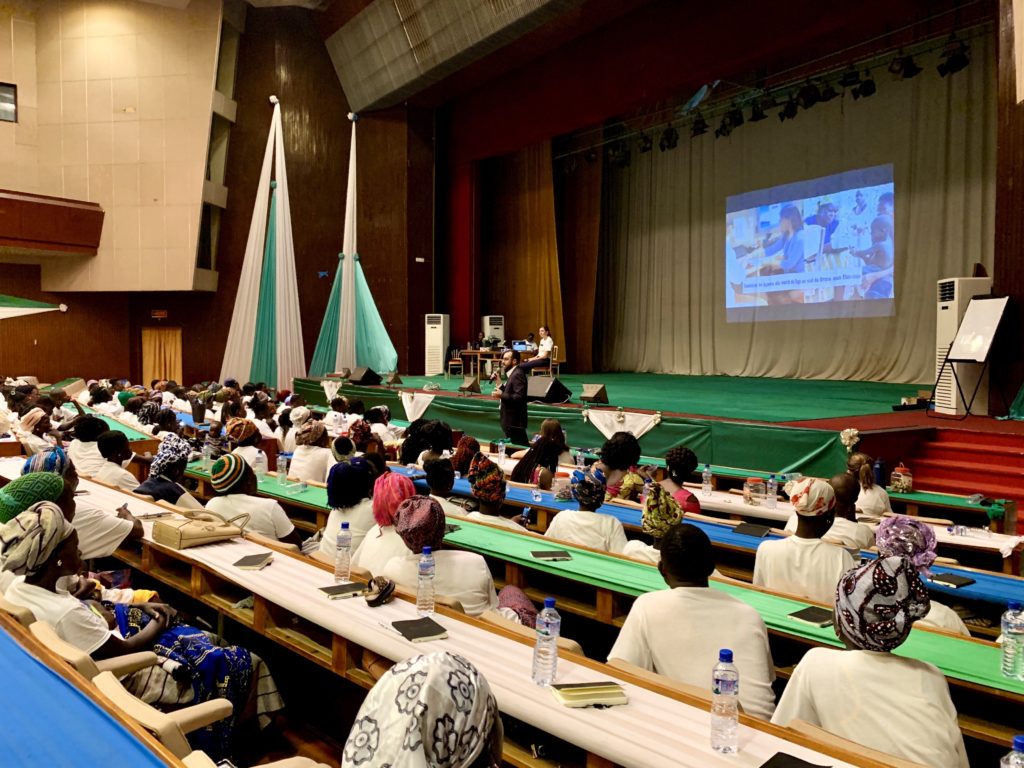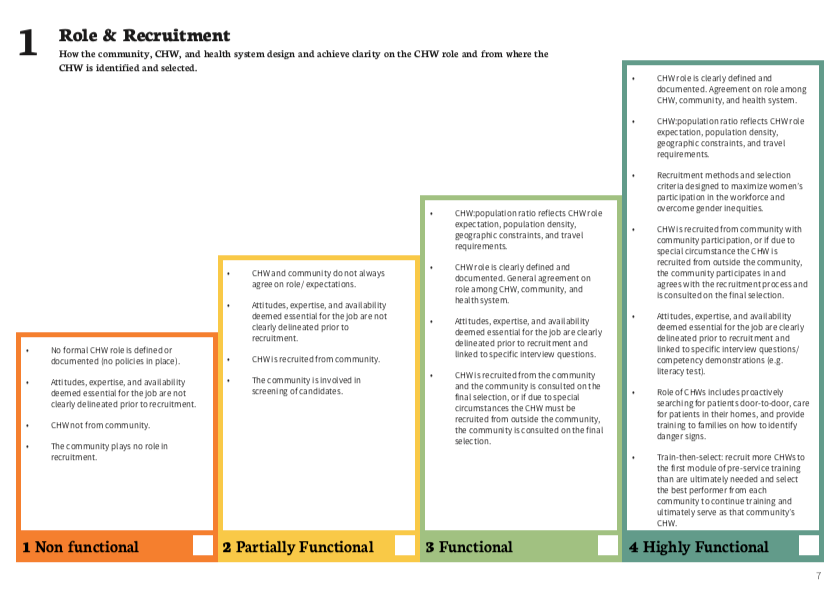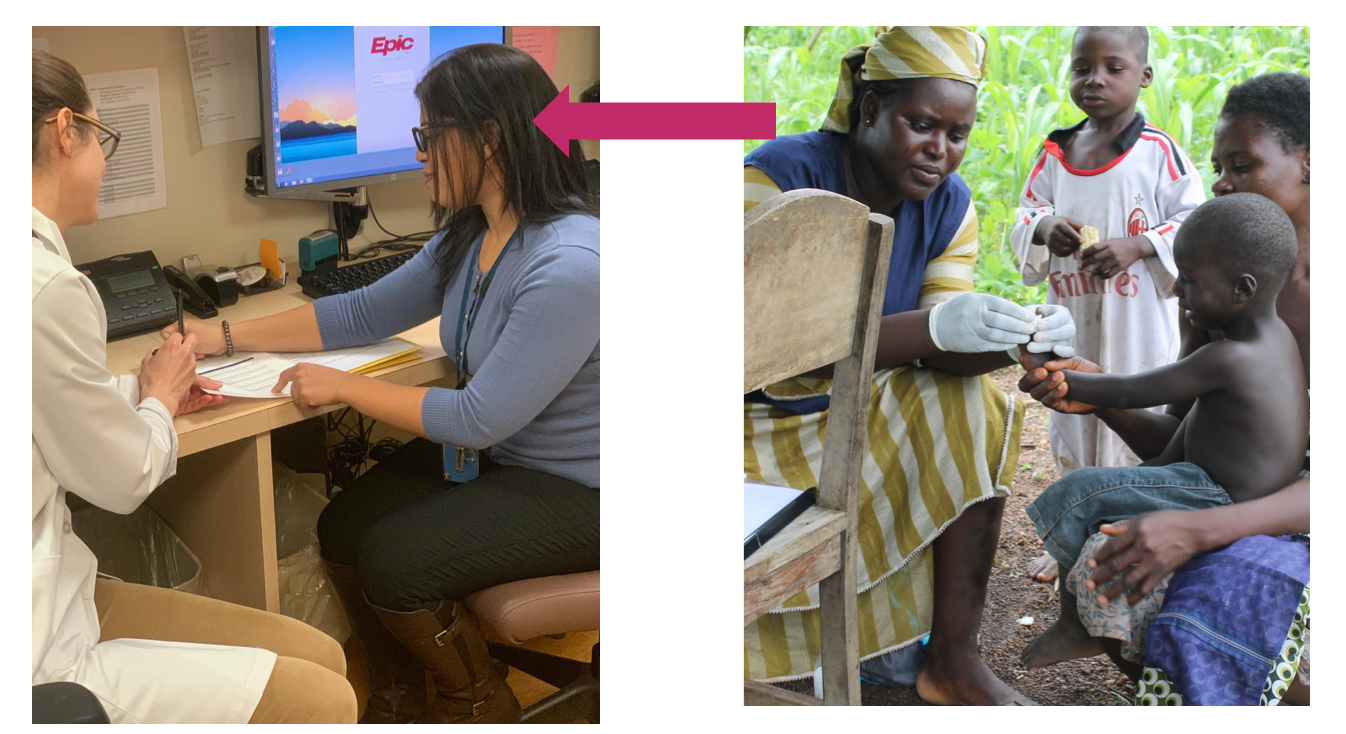At an All-Staff Meeting in Togo last August, Dr. Kevin Fiori, Co-Founder and Chief Science Officer of Integrate Health, presented to an audience of over 130 people, including 95 Community Health Workers, about how their work has directly informed the work of Community Health Workers across an ocean in the Bronx. As Dr. Fiori detailed the ways in which Community Health Workers (CHWs) in the Bronx have learned from and adopted innovations developed in Togo, excitement spread across the room. As the presentation was wrapping up, Dr. Fiori reiterated his belief in the CHWs, stating:
“You are not a model; you are THE model for the rest of the world. Please continue, the world is watching you.”
It was a remarkable moment filled with incredible pride and deep gratitude for the commitment that the CHWs and Integrate Health staff have shown in the pursuit of saving lives.

To help translate lessons learned from one community to another, Integrate Health staff both in Togo and in the Bronx used the Community Health Worker Assessment and Improvement Index (CHW AIM) tool. The tool was initially developed by USAID Health Care Improvement Project in 2011 and was revised in 2018 by USAID, UNICEF, and members of the Community Health Impact Coalition, including Dr. Fiori. It provides a framework of evidence-based practices in which users assess a community health system domain on a scale of one to four, with one representing not functional and four representing highly functional.

While also leading Integrate Health’s research, Dr. Fiori is a full-time doctor at Montefiore Health System in the Bronx, New York. When Dr. Fiori joined a collaboration to integrate social needs assessment and outreach between the Bronx Community Health Network and Montefiore Health System, he noted that the there was room to optimize an established CHW program. In turn, the team piloted the Community Linkage to Care program, which aims to enhance the integration of unmet social needs screening with CHW outreach support. Dr. Fiori and team used the CHW AIM tool to assess the current state of the Community Linkage to Care program and call upon lessons learned in Togo.
Fast forward a few months, and as part of continuous improvement efforts, Integrate Health staff gathered together to use the same CHW AIM tool to evaluate our own CHW program. Integrate Health’s Program Director, P. Émile Bobozi, led the team through the exercise of using the tool. In order to accurately understand the program at all levels, CHW supervisors, coordinators, and clinical mentors from all three of the districts in which Integrate Health currently operates were asked to submit their rating for each criterion and provide justification for each rating. In turn, the ratings were discussed amongst the Programs team; the Partnership team; and the Monitoring, Evaluation, and Quality Improvement team until a mutual rating was agreed upon.
Both Dr. Fiori and Mr. Bobozi noted how easy the tool was to use despite differences in context and program goals; the Community Linkage to Care program is focused on effective screening of social needs in an urban American city, while Integrate Health’s Integrated Primary Care program is focused on diagnosing and treating curable diseases mainly in rural West African villages.
Dr. Fiori remarked on the Bronx-based teams use of the tool and found that “despite different contexts, population densities, languages, cultures, and even CHW function, there are systematic domains that transcend these differences and help optimize CHW programs.”
For example, Dr. Fiori noted that the categories “Linkage to the Health System” and “Role & Recruitment” were important across both countries, although the implementation differs. To improve the Bronx CHWs linkage to the public health system, he started by reflecting on the ways in which Integrate Health had been successful in this category. In collaboration with the Togolese Ministry of Health, Integrate Health clearly defines the role of its CHWs, including which services they are trained to provide and the ways in which CHWs should interact with the health system, such as improving patients access to the public health system through referrals. In turn, the Bronx team modified this approach to fit the US healthcare system by defining and integrating CHW roles into the clinical workflow at Montefiore Health System. An important lesson learned from Togo, Dr. Fiori explained, is that once the clinical team better understands the role of the CHW, such as when to refer a patient to a CHW, CHWs will have a larger impact on their patients. Recently, Dr. Fiori and team members published an article in the Journal for Primary Care & Community Health, which highlights the importance of defining these roles.
In Togo, at the beginning of the workshop to use the CHW AIM tool, it seemed as though Integrate Health’s program was excelling in every domain. Kandasi Griffiths, Integrate Health’s Health Systems Manager, remarked that for the first couple of criteria, “most agreed it was a four.” However, as the team thought more about the purpose of the activity to evaluate cross-sectionally and improve quality, they went back to the initial criteria with a more astute approach.
“In what areas are we doing the work, but the practice remains informal? How do we systematize those processes? How do we prepare this model for a larger scale?”
As the team asked themselves these questions, areas for improvement became clear. “We didn’t always score 100%,” commented Mr. Bobozi. For example, the program scored a one in the category of “Possibilities For Advancement” due to the fact that Integrate Health does not yet have a formal program to support CHWs who would like to pursue career advancement. Even in the categories where the program ranked three or four, the team chose to focus on the opportunities for progress.
Mr. Bobozi was inspired after receiving the scores, particularly in the categories of “Training” and “Linkage to the Health System.” He saw a window of opportunity to direct additional improvements. Immediately, he implemented a clinical practicum for the group of CHWs who had recently received training on family planning. The month-long internship of a few hours per week will allow the CHWs to work closely with public sector nurses and midwives, studying their techniques and developing a better sense of their work in the clinic. At the end of January, CHWs will graduate from the program. The CHWs now have the opportunity to improve their skills and are building an even stronger connection to the public clinic.
“Through the use of this tool,” Mr. Bobozi explained, “we can see where we need to improve.”

Recently, the Togolese Minister of Health participated in a workshop hosted by the Community Health Impact Coalition in New York on the CHW AIM tool. The Minister noted the potential use of the CHW AIM tool to assess and explore opportunities for improvement within Togo’s national community health program and requested Integrate Health’s collaboration on rolling out a similar evaluation. Just as was done by our Integrate Health team in Togo and Dr. Fiori’s team in the Bronx, we hope to support the Ministry of Health in using this tool to innovate, iterate, and improve on the current system. Through this process, we will continue to share lessons learned and best practices to increase the effectiveness of CHW programs around the world.
